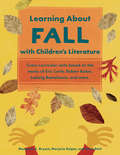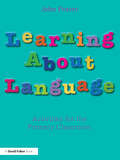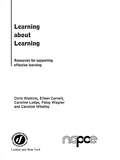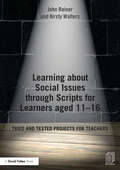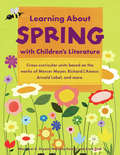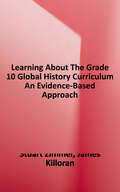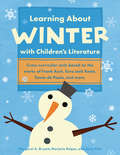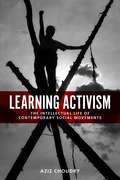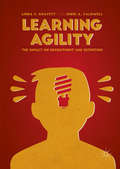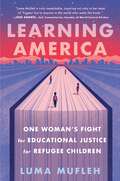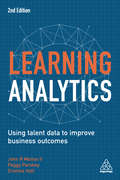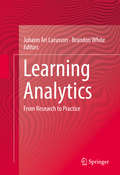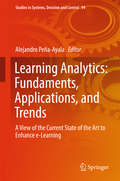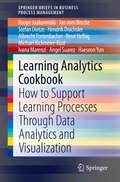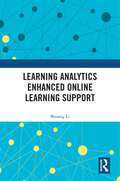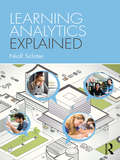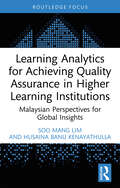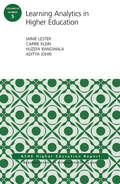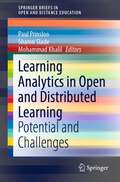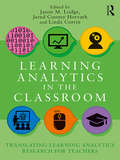- Table View
- List View
Learning About Fall with Children's Literature: Cross-curricular Units Based On The Works Of Eric Carle, Robert Kalan, Ludwig Bemelmans And More
by Margaret Bryant Anne Petit Marjorie KeiperTaking a thematic approach to learning that employs seeing, hearing, reading, and writing, these books outline three four-week, cross-curricular units that develop the competencies children need to become fluent, independent readers and writers. While each unit focuses primarily on language--phonic skills, structural analysis, punctuation, capitalization, poetry, and comprehension--they also include math, science, social studies, music, art, and even mini-lessons in French for cross-cultural appreciation. Understanding that student ability levels in younger grades can vary widely, lesson plans are keyed to three types of learners: emerging, typical, and advanced. The series includes three titles that cover fall, spring, and winter, and each can be used independently or together throughout the school year.
Learning about Language: Activities for the Primary Classroom
by John FosterBringing a fresh and lively approach to language study, Learning about Language is an exciting collection of fun, creative activities and warm-up games that explore the multifaceted nature of the English language. For use in any primary classroom, this book will help develop the pupil’s knowledge of how the English language works and will improve their ability to use language effectively. Throughout the book, the author explains key features of the English language by arranging the volume alphabetically into sections, each of which explores a different linguistic feature. Foster suggests enjoyable activities that will enable students to consolidate their learning and improve their communication skills through word play, and frequently uses rhyme to illustrate and elaborate on points made. Areas covered include: Spelling, punctuation and grammar; Origin, meaning, similarities and differences of words, including homonyms, anagrams and synonyms; The explanation of particular uses of language for specific purposes; Humorous misuse of words, including malapropisms and spoonerisms; The inclusion of numerous opportunities for students to play with words by participating in word games and through their own writing. With its unique and accessible approach to language study, Learning about Language provides teachers of English with a dynamic collection of resources that will be welcomed by educators and students alike.
Learning about Learning: Resources for Supporting Effective Learning
by Eileen Carnell Caroline Lodge Patsy Wagner Chris Watkins Caroline WhalleyThis practical A4 pack contains activities and ideas for teachers and students to learn more about learning. Learning about Learningis a practical way of teaching important and neglected theories of learning.The idea is that if teachers and students learn about what learning is and how it happens they understand a greater range of learning possibilities and approaches and improve their learning and teaching skills.
Learning about Social Entrepreneurship and Management in Times of Social Transformation (Ethical Economy #66)
by Luise Li Langergaard Katia Dupret Jennifer EschweilerThe book brings together perspectives on entrepreneurship research, education and practice to understand social entrepreneurship in its wider societal, political and economic context. Its unique contribution comes from its interdisciplinary approach that spans from the societal to the organizational level, with specific focus social innovation and management. It views management of social entrepreneurship and social enterprise in light of its societal context and employs social innovation to critically assess social entrepreneurship as driver of change. The emergence of social entrepreneurship as an academic field is linked to several societal trends such as public austerity, financial crises, new social challenges and a growing counter-movement to globalised capitalism. Generally seen as organisations serving both social and economic objectives, social enterprises, social innovation and social entrepreneurship have their roots in civil society, civic activism or the solidarity economy, but also manifest themselves as for-profit companies, with new organisational forms emerging and old ones changing. The contributions in this book elucidate these developments and the role of social entrepreneurs and social enterprises. Furthermore, the book offers great insight into the specific ways of managing, leading and creating innovation in social enterprises as well as perspectives on how to understand their social impact or value creation.
Learning about Social Issues through Scripts for Learners aged 11-16: Tried and tested projects for teachers
by John Rainer Kirsty WaltersLearning about Social Issues through Scripts for Learners aged 11-16 offers secondary drama teachers a new and exciting approach to exploring social issues with their students. Focusing on the issues that matter to young people, it includes a wide range of classroom and performance materials carefully tailored for differing abilities and ages. The book is based around four original play scripts exploring themes of antisocial behaviour, eating disorders, the effects of war on families and riots – that have been tried, tested and proven to motivate and engage young people. As well as building performance skills, each script is accompanied by detailed schemes of work to help students explore what the issues mean to them and develop their problem solving and thinking skills. The book also includes cross references to pedagogical techniques and approaches, assessment for learning and ‘learning to learn’. Written by an experienced author team, Learning about Social Issues through Scripts for Learners aged 11-16 provides a ‘one-stop shop’ for teachers to explore relevant and stimulating themes and topics that will engage students in lively debate, promote empathy and produce creative dramatic responses.
Learning About Spring with Children's Literature
by Margaret Bryant Anne Petit Marjorie KeiperTaking a thematic approach to learning that employs seeing, hearing, reading, and writing, these books outline three four-week, cross-curricular units that develop the competencies children need to become fluent, independent readers and writers. While each unit focuses primarily on language--phonic skills, structural analysis, punctuation, capitalization, poetry, and comprehension--they also include math, science, social studies, music, art, and even mini-lessons in French for cross-cultural appreciation. Understanding that student ability levels in younger grades can vary widely, lesson plans are keyed to three types of learners: emerging, typical, and advanced. The series includes three titles that cover fall, spring, and winter, and each can be used independently or together throughout the school year.
Learning About the Grade 10 Global History Curriculum: An Evidence-Based Approach
by Stuart Zimmer James KilloranThis book is organized around the New York State Grade 10 Social Studies Framework. If it has anything to do with the Grade 10 curriculum in Social Studies, it is covered in this book. The book is designed to help you do your best in Global History and Geography. To accomplish that end, the book is divided into three parts: Introductory Unit, Content Chapters, and Final Review Unit.
Learning About Winter with Children's Literature
by Margaret Bryant Anne Petit Marjorie KeiperTaking a thematic approach to learning that employs seeing, hearing, reading, and writing, these books outline three four-week, cross-curricular units that develop the competencies children need to become fluent, independent readers and writers. While each unit focuses primarily on language--phonic skills, structural analysis, punctuation, capitalization, poetry, and comprehension--they also include math, science, social studies, music, art, and even mini-lessons in French for cross-cultural appreciation. Understanding that student ability levels in younger grades can vary widely, lesson plans are keyed to three types of learners: emerging, typical, and advanced. The series includes three titles that cover fall, spring, and winter, and the books can be used independently or together throughout the school year.
Learning Across Sites: New Tools, Infrastructures and Practices (New Perspectives on Learning and Instruction)
by Sten LudvigsenThe ever evolving, technology-intensive nature of the twenty-first century workplace has caused an acceleration in the division of labour, whereby work practices are becoming highly specialised and learning and the communication of knowledge is in a constant state of flux. This poses a challenge for education and learning: as knowledge and expertise increasingly evolve, how can individuals be prepared through education to participate in specific industries and organisations, both as newcomers and throughout their careers? Learning Across Sites brings together a diverse range of contributions from leading international researchers to examine the impacts and roles which evolving digital technologies have on our navigation of education and professional work environments. Viewing learning as a socially organised activity, the contributors explore the evolution of learning technologies and knowledge acquisition in networked societies through empirical research in a range of industries and workplaces. The areas of study include public administration, engineering, production, and healthcare and the contributions address the following questions: How are learning activities organised? How are tools and infrastructures used? What competences are needed to participate in specialised activities? What counts as knowledge in multiple and diverse settings? Where can parallels be drawn between workplaces? Addressing an emerging problem of adaptation in contemporary education, this book is essential reading for all those undertaking postgraduate study and research in the fields of educational psychology, informatics and applied information technology.
Learning Activism: The Intellectual Life Of Contemporary Social Movements
by Aziz ChoudryWhat do activists know? Learning Activism is designed to encourage a deeper engagement with the intellectual life of activists who organize for social, political, and ecological justice. Combining experiential knowledge from his own activism and a variety of social movements, Choudry suggests that such organizations are best understood if we engage with the learning, knowledge, debates, and theorizing that goes on within them. Drawing on Marxist, feminist, anti-racist, and anti-colonial perspectives on knowledge and power, the book highlights how activists and organizers learn through doing, and fills the gap between social movement practice as it occurs on the ground, critical adult education scholarship, and social movement theorizing. Examples include anti-colonial currents within global justice organizing in the Asia-Pacific, activist research and education in social movements and people's organizations in the Philippines, Migrant and immigrant worker struggles in Canada, and the Quebec student strike. The result is a book that carves out a new space for intellectual life in activist practice.
Learning Agility
by Linda S. Gravett Sheri A. CaldwellThis book concretely defines the concept of learning agility and offers a business case for why organizations of all types should concentrate on building and sustaining this approach. It provides readers with a holistic approach towards the topic, and helps leaders leverage the learning agility of individual employees to sustain a learning-agile workplace culture. Synthesizing academic research and practical approaches, this book takes leaders through ways to interview and assess potential employees for learning agility, develop and foster an environment for learning agility, and measure the results of a learning agile workplace. The authors present an innovative learning agility assessment which has been developed, tested, and implemented by clients and outline metrics which can measure the results of a learning agile workforce. This little-understood but highly advantageous approach is crucial for leaders to understand if they wish to deliver results and impact their organizations' bottom line.
Learning America: One Woman's Fight for Educational Justice for Refugee Children
by Luma MuflehA visionary leader&’s powerful personal story and a blueprint for change that will inspire schools and communities across AmericaLuma Mufleh—a Muslim woman, a gay refugee from hyper-conservative Jordan—joins a pick-up game of soccer in Clarkston, Georgia. The players, 11- and 12-year-olds from Liberia and Afghanistan and Sudan, have attended local schools for years. Drawn in as coach of a ragtag but fiercely competitive team, Mufleh discovers that few of her players can read a word. She asks, &“Where was the America that took me in? That protected me? How can I get these kids to that America?&” For readers of Malala, Paul Tough, and Bryan Stevenson, Learning America is the moving and insight-packed story of how Luma Mufleh grew a soccer team into a nationally acclaimed network of schools—by homing in laserlike on what traumatized students need in order to learn. Fugees accepts only those most in need: students recruit other students, and all share a background of war, poverty, and trauma. No student passes a grade without earning it; the failure of any student is the responsibility of all. Most foundational, everyone takes art and music and everyone plays soccer, areas where students make the leaps that can and must happen—as this gifted refugee activist convinces—even for America&’s most left-behind.
Learning Analytics: Measurement Innovations to Support Employee Development
by Mark Van Buren Jean Martin John MattoxFaced with organizations that are more dispersed, a workforce that is more diverse and the pressure to reduce costs, CEOs and CFOs are increasingly asking what the return on investment is from training and development programmes. Learning Analytics provides a framework for understanding how to work with learning analytics at an advanced level. It focuses on the questions that training evaluation is intended to answer: is training effective and how can it be improved? It discusses the field of learning analytics, outlining how and why analytics can be useful, and takes the reader through examples of approaches to answering these questions and looks at the valuable role that technology has to play. Even where technological solutions are employed, the HR or learning and development practitioner needs to understand what questions they should be asking of their data to ensure alignment between training and business needs.Learning Analytics enables both senior L&D and HR professionals as well as CEOs and CFOs to see the transformational power that effective analytics has for building a learning organization, and the impacts that this has on performance, talent management, and competitive advantage. It helps learning and development professionals to make the business case for their activities, demonstrating what is truly adding value and where budgets should be spent, and to deliver a credible service to their business by providing metrics based on which sound business decisions can be made.
Learning Analytics: Using Talent Data to Improve Business Outcomes
by Cristina Hall John R Mattox II Peggy ParskeyEffective evaluation and measurement of learning and development initiatives is critical to maximise the impact of training, identify gaps for improvement and ensure that efforts are aligned to the business' needs. Learning Analytics outlines how analytical approaches can respond to these challenges, the types and benefits of technological solutions and how to ask the right questions of organizational data in order to build a learning organization that boosts performance and competitive advantage.Drawing upon case studies from organizations who have applied such approaches such as The Gap, Hilton Worldwide University and Seagate Technology, Learning Analytics will enable those involved in learning and development to make the business case for their activities and deliver an evidence-based service to their organizations. Alongside updated chapters on learning technology tools and moving beyond learning analytics to talent management analytics, this second edition also features new content on measuring informal learning, increasing data literacy, and framing L&D's contributions through a portfolio evaluation approach.
Learning Analytics
by Johann Ari Larusson Brandon WhiteIn education today, technology alone doesn't always lead to immediate success for students or institutions. In order to gauge the efficacy of educational technology, we need ways to measure the efficacy of educational practices in their own right. Through a better understanding of how learning takes place, we may work toward establishing best practices for students, educators, and institutions. These goals can be accomplished with learning analytics. Learning Analytics: From Research to Practice updates this emerging field with the latest in theories, findings, strategies, and tools from across education and technological disciplines. Guiding readers through preparation, design, and examples of implementation, this pioneering reference clarifies LA methods as not mere data collection but sophisticated, systems-based analysis with practical applicability inside the classroom and in the larger world. Case studies illustrate applications of LA throughout academic settings (e. g. , intervention, advisement, technology design), and their resulting impact on pedagogy and learning. The goal is to bring greater efficiency and deeper engagement to individual students, learning communities, and educators, as chapters show diverse uses of learning analytics to: Enhance student and faculty performance. Improve student understanding of course material. Assess and attend to the needs of struggling learners. Improve accuracy in grading. Allow instructors to assess and develop their own strengths. Encourage more efficient use of resources at the institutional level. Researchers and practitioners in educational technology, IT, and the learning sciences will hail the information in Learning Analytics: From Research to Practice as a springboard to new levels of student, instructor, and institutional success.
Learning Analytics: Fundaments, Applications, and Trends
by Alejandro Peña-AyalaThis book provides a conceptual and empirical perspective on learning analytics, its goal being to disseminate the core concepts, research, and outcomes of this emergent field. Divided into nine chapters, it offers reviews oriented on selected topics, recent advances, and innovative applications. It presents the broad learning analytics landscape and in-depth studies on higher education, adaptive assessment, teaching and learning. In addition, it discusses valuable approaches to coping with personalization and huge data, as well as conceptual topics and specialized applications that have shaped the current state of the art. By identifying fundamentals, highlighting applications, and pointing out current trends, the book offers an essential overview of learning analytics to enhance learning achievement in diverse educational settings. As such, it represents a valuable resource for researchers, practitioners, and students interested in updating their knowledge and finding inspirations for their future work.
Learning Analytics Cookbook: How to Support Learning Processes Through Data Analytics and Visualization (SpringerBriefs in Business Process Management)
by Roope Jaakonmäki Stefan Dietze Hendrik Drachsler Albrecht Fortenbacher René Helbig Michael Kickmeier-Rust Ivana Marenzi Angel Suarez Haeseon Yun Jan vom BrockeThis book offers an introduction and hands-on examples that demonstrate how Learning Analytics (LA) can be used to enhance digital learning, teaching and training at various levels. While the majority of existing literature on the subject focuses on its application at large corporations, this book develops and showcases approaches that bring LA closer to smaller organizations, and to educational institutions that lack sufficient resources to implement a full-fledged LA infrastructure. In closing, the book introduces a set of software tools for data analytics and visualization, and explains how they can be employed in several LA scenarios.
Learning Analytics Enhanced Online Learning Support
by Shuang LiOffering the latest developments in online education in the era of big data, this book explores theories, technologies, and practices in the field of data-driven online learning support services using learning analytics. This book is divided into five chapters. Chapter 1 reflects and reconstructs the connotation of learning support against the backdrop of education reform, the rise of learning analytics, and the upgrading of the demand for learning services in the new era. Chapter 2 presents a P-K-DSE-E model of online learner characteristics and discusses measurement and data representation methods for learner characteristics based on it. Chapters 3–5 focus on the three types of learning support that are closely related to learning performance and satisfaction, including the promotion of social learning, electronic learning assessment based on the learning process, and personalized tutoring and support. This book innovatively develops the concept, theory, and practical methods of student support services in distance education traditional practices in the new era and provides valuable exploration of data-driven personalized learning service methods and technologies in the era of artificial intelligence through rich examples. This book will be essential reading for students and scholars of distance and online education, educational technology, and audiovisual education.
Learning Analytics Explained
by Niall SclaterLearning Analytics Explained draws extensively from case studies and interviews with experts in order to discuss emerging applications of the new field of learning analytics. Educational institutions increasingly collect data on students and their learning experiences, a practice that helps enhance courses, identify learners who require support, and provide a more personalized learning experience. There is, however, a corresponding need for guidance on how to carry out institutional projects, intervene effectively with students, and assess legal and ethical issues. This book provides that guidance while also covering the evolving technical architectures, standards, and products within the field.
Learning Analytics for Achieving Quality Assurance in Higher Learning Institutions: Malaysian Perspectives for Global Insights (Routledge Research in Higher Education)
by Soo Mang Lim Husaina Banu KenayathullaThis book explores Learning Analytics (LA) programmes and practices in Malaysia as well as looking at the underlying forces, dilemmas and policy challenges for quality assurance in higher education institutions (HEIs). This chapters provide a comprehensive discussion of trends in academic quality assurance in higher education. It articulates a combination of theoretical issues and empirical analysis and offers a comprehensive guide to stakeholders in Management and Faculty on LA implementation in HEIs where the model in this book can be used to pave the way for a successful LA initiative. Learning Analytics is an emerging multidisciplinary technological practice with the ultimate goal of producing effective learning to improve students’ achievement in the tertiary level. The Learning Analytics model of Quality Assurance in this book is an essential guide for any faculty or manager in higher education, or researchers in higher education and learning analytics.
Learning Analytics Goes to School: A Collaborative Approach to Improving Education
by Andrew Krumm Barbara Means Marie BienkowskiLearning Analytics Goes to School presents a framework for engaging in education research and improving education practice through the use of newly available data sources and analytical approaches. The application of data-intensive research techniques to understanding and improving learning environments has been growing at a rapid pace. In this book, three leading researchers convey lessons from their own experiences—and the current state of the art in educational data mining and learning analytics more generally—by providing an explicit set of tools and processes for engaging in collaborative data-intensive improvement.
Learning Analytics in Higher Education: Current Innovations, Future Potential, and Practical Applications
by Jaime Lester Carrie Klein Aditya Johri Huzefa RangwalaLearning Analytics in Higher Education provides a foundational understanding of how learning analytics is defined, what barriers and opportunities exist, and how it can be used to improve practice, including strategic planning, course development, teaching pedagogy, and student assessment. Well-known contributors provide empirical, theoretical, and practical perspectives on the current use and future potential of learning analytics for student learning and data-driven decision-making, ways to effectively evaluate and research learning analytics, integration of learning analytics into practice, organizational barriers and opportunities for harnessing Big Data to create and support use of these tools, and ethical considerations related to privacy and consent. Designed to give readers a practical and theoretical foundation in learning analytics and how data can support student success in higher education, this book is a valuable resource for scholars and administrators.
Learning Analytics in Higher Education: ASHE Higher Education Report (J-B ASHE Higher Education Report Series (AEHE))
by Jaime Lester Carrie Klein Huzefa Rangwala Aditya JohriLearning analytics (or educational big data) tools are increasingly being deployed on campuses to improve student performance, retention and completion, especially when those metrics are tied to funding. Providing personalized, real-time, actionable feedback through mining and analysis of large data sets, learning analytics can illuminate trends and predict future outcomes. While promising, there is limited and mixed empirical evidence related to its efficacy to improve student retention and completion. Further, learning analytics tools are used by a variety of people on campus, and as such, its use in practice may not align with institutional intent. This monograph delves into the research, literature, and issues associated with learning analytics implementation, adoption, and use by individuals within higher education institutions. With it, readers will gain a greater understanding of the potential and challenges related to implementing, adopting, and integrating these systems on their campuses and within their classrooms and advising sessions. This is the fifth issue of the 43rd volume of the Jossey-Bass series ASHE Higher Education Report. Each monograph is the definitive analysis of a tough higher education issue, based on thorough research of pertinent literature and institutional experiences. Topics are identified by a national survey. Noted practitioners and scholars are then commissioned to write the reports, with experts providing critical reviews of each manuscript before publication.
Learning Analytics in Open and Distributed Learning: Potential and Challenges (SpringerBriefs in Education)
by Paul Prinsloo Sharon Slade Mohammad KhalilThis book explores and further expands on the rich history of theoretical and empirical research in open and distributed learning, and addresses the impact of the “data revolution” and the emergence of learning analytics on this increasingly diverse form of educational delivery. Following an introductory chapter that maps the book’s conceptual rationale, the book discusses the potential, challenges and practices of learning analytics in various open and distributed contexts. A concluding chapter briefly summarises the chapters before providing a tentative future research agenda for learning analytics in open and distributed environments.
Learning Analytics in the Classroom: Translating Learning Analytics Research for Teachers
by Jason M. Lodge Jared Cooney Horvath Linda CorrinLearning Analytics in the Classroom presents a coherent framework for the effective translation of learning analytics research for educational practice to its practical application in different education domains. Highlighting the real potential of learning analytics as a way to better understand and enhance student learning and with each chapter including specific discussion about what the research means in the classroom, this book provides educators and researchers alike with the tools and frameworks to effectively make sense of and use data and analytics in their everyday practice. This volume is split into five sections, all of which relate to the key themes in understanding learning analytics through the lens of the classroom: broad theoretical perspectives understanding learning through analytics the relationship between learning design and learning analytics analytics in the classroom and the impact it can and will have on education implementing analytics and the challenges involved. Bridging the gap between research, theory and practice, Learning Analytics in the Classroom is both a practical tool and an instructive guide for educators, and a valuable addition to researchers' bookshelves. A team of world-leading researchers and expert editors have compiled a state-of-the-art compendium on this fascinating subject and this will be a critical resource for the evolution of this field into the future.
